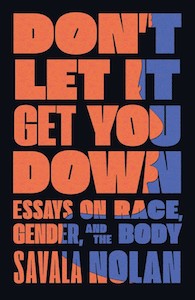
How I Survived a Racialized Pregnancy in the American Healthcare System
Savala Nolan on the Medical Field’s Cruel Indifference to Black Mothers
My mom gave my daughter, Gemma, a white doll, and I seethed. The doll was a pudgy velour newborn with a piglet-colored face, opaque blue eyes, and yellow-yarn hair. Glancing at my husband, I suppressed my instinct to take it away. I didn’t want to ruin the moment. So I let my daughter play with the doll, squishing and rocking its body and grinning up at me. I sat silent and still and smarting at the dining room table, unable to take the doll, unable to open my mouth and speak, as if my hands were suddenly covered in papercuts and my mouth full of fallen-out teeth.
The doll repulsed me because it erased me. It was like I was outside our living room looking in the window, and instead of seeing myself in this family scene, I saw a white woman in my place. After all, the only child whose first doll should be white is a white child; my child, though she has a white dad and is light-skinned, is black because I am. I am her mother. This indignance is about self-respect, and also pain; I am the blackness in Gemma, and my blackness made it that much harder for me to create and birth her. This white doll took my body, which slogged through this country’s racial hierarchy to make and deliver my only child, and expunged it from the record.
My pregnancy and Gemma’s birth were bad enough that, though I’ve always wanted a big family, I can’t imagine being pregnant or giving birth again. I’m haunted by the loss of this dream, and by the fact that race is part of why I lost it. So I want credit for surviving a racialized pregnancy—probably the only one I’ll ever have. I want a warrior’s welcome, I want to be held and healed, not to be slid out of view by a doll that suggests, however subtly, that I’m not here.
*
It started with worry, a mesh of fear that defined every day of my pregnancy: I worried about getting UTIs; the pain of labor and delivery; whether my husband would be a good birth coach; defects and anomalies; unwashed lettuce in the salad bar at Whole Foods; undercooked scrambled eggs and French toast in restaurants; whether the monitors they wrapped around my belly hurt the baby; stillbirth; breastfeeding (Were my boobs changing enough? How many calories would it burn? Had I bought enough nursing pads and nipple cream?); the baby shower and what size dress I’d be wearing; whether my thyroid dose was high enough to prevent late-term miscarriage; whether I would weigh 300 pounds by the time I gave birth (actually, not metaphorically); whether the nausea medication I finally agreed to consume—a pricey compound of vitamin B and Unisom—was safe.
In my last trimester, my heart started racing irregularly for hours at a time and I’d get light-headed and sweaty. One morning, my husband and I drove in freezing rain to the ER because the thumping in my chest was so frenzied. I had mentioned these episodes at multiple appointments with my (white) midwives and (white) ob-gyns and my (white) endocrinologist. They said it was nothing. “Your body does weird things in pregnancy.” I felt they were wrong; the feeling was a ripple of intuition in my gut that moved tightly. It wasn’t just anxiety. It had a soberness, a foreshadowing quality that my anxiety doesn’t.
They dismissed me—your body does weird things in pregnancy—as they would again when they waved away my concerns about something else, too: a vomit-inducing pain I’d get in my upper back a couple times a month. The pain and vomiting were so intense that I’d drop to the floor when they started, writhing and wailing and puking until, 15 or 20 minutes later, it passed. We told my nurses and doctors. They had no ideas, no suggestions. They ran no tests. They told me to go home and try Tums. When I threw up the Tums, they told me, inexplicably, that the Tums had probably caused the vomiting. They told me it was stress. They said to try chiropractic—maybe my ribs were out of alignment. We went to the ER again during one episode because I feared I was going to die; the (white) nurse raised her eyebrows, looked at my boobs, and told me I should try a more supportive bra. The episodes continued.
In labor, my jagged heartbeat appeared. My pulse was 175 as I lay resting, hands rubbing my belly. A nurse brought me a Styrofoam cup of mint tea that tasted like plastic and a vial of lavender oil to smell. After an EKG, a cardiologist entered the labor and delivery room and confirmed what I had intuited: the racing-pulse symptoms I’d had for months were from a heart condition. He’d just diagnosed me, sort of—he suspected gestational atrial fibrillation but couldn’t confirm it wasn’t a different, lethal problem without more tests—and those tests would have to wait because I was in labor. I was crying, but he ignored that, staying light-hearted and upbeat. He said, “We hope it’s a-fib. If it’s a-fib, that’s mostly just a pain in the ass.” In any event, he said, they were transferring me into the cardiac ICU.
I cried as my bed wheels squeaked down the bright, white hallway. The cardiac ICU has the same sterile, unmoving chilliness of a funeral home. Bodies are curling inward, becoming unavailable to life’s in-and-out exchange of energy. Around me, dozens of elderly white men lay with their eyes closed and dry mouths hanging open. They set me up in a room with glass walls that faced the nursing stations; I looked nervously at my husband. “Am I going to be facing this glass wall?” Eventually a nurse stood on her tippy-toes to tape up a sheet. But I could not shake the thought of Sara Baartman—the “Hottentot Venus”—and how, in the 1800s, her body became a spectacle under the white gaze of science, how a British doctor forcibly displayed her at London’s Piccadilly Circus while she wore feathers and greeted onlookers, how, after her death, her genitals were displayed at a Paris museum until 1974, six years before I was born.
Doctors came and went, crowding into the doorway. “Everybody’s heard about you, a lady giving birth in the cardiac ICU!” One told me what would happen if my heart raced so fast that I passed out: they’d have to shock me, and it would hurt. He’d never done it to a pregnant woman. Lab technicians stuck needles in my hand for blood draws. Nurses leaned on the wall, watching me groan through Pitocin-fueled, back-labor contractions. One of them said I was graceful. At the time it felt like a compliment. Now I recall it and my stomach crunches in anger. A dozen cords wrapped my torso and disappeared into the machines that surrounded the bed. The machines emitted an agitating hum and frequent beeps. They continuously measured my blood pressure, heart rate and electrical activity, and blood oxygen. They monitored Gemma’s vital signs but kept losing them as she moved. I was not permitted to eat or drink. I couldn’t sleep, and could only move briefly and awkwardly or I’d disturb the machines and wires. This continued for over 24 hours.
I wish that my infant daughter and I had not been sharing a body while I was being judged by whiteness.
I remember frayed, sharp-edged things from the morning Gemma was born: the doctors at my feet; the Black one exhorting me to Push!; the heat before fainting getting tighter around my head; the ice-blue fluorescent light; my husband’s expression contorted and twisting with emotion; someone saying, Do you want to feel your baby?; reaching down and touching her crowning skull—tangible! Miraculous!—and thinking of the wet swirl of curls on a newborn calf’s head; the slup-slup of one shoulder and the next coming out of me; her body fat and slick as a seal, and lavender-gray; someone saying, She isn’t breathing; yelling to my husband, Go be with Gemma!; eventually hearing her cry; a resident stitching my tear, serious one minute but goofy the next as he tried to make light of misfiring the needle and thread.
If I were a white lady, a thin one, I believe it would have gone differently. I can’t know for sure, but social science supports my hunch. We know medical students sometimes don’t believe Black people feel as much pain as white people do. We know Black people are less likely to be given diagnostic medical tests. We know Black women are more likely to die in childbirth regardless of socioeconomic status. So, had I been white, someone might have taken my heart palpitations and my painful vomiting seriously. They might have had the doctor, not the resident, stitch my third-degree tear. They might have let me see my placenta—I begged them to, it was a part of my body, I’d made it to feed my daughter—instead of whipping it away in a biohazard bowl. They might have listened when I asked to see my newborn more than once a day as I recovered alone in the cardiac ICU. They might have diagnosed me earlier.
Six months after Gemma was born I had maybe my tenth of those cratering, concussive pain-and-vomiting episodes, the pain so extraordinary that I peed myself and was seeing double. I waited to go to the emergency room, thinking, as I’d been repeatedly told, it was just stress or muscle spasms, or maybe even a flashback to labor trauma; when I finally got there, all I could do was whimper Help me.
Once admitted, I was diagnosed with acute pancreatitis, which can kill you, and which, in my case, required urgent surgery. I had been showing textbook symptoms for months. I had been showing textbook symptoms for months. I had been showing textbook symptoms for months.
I want credit for surviving a racialized pregnancy. I want a warrior’s welcome, not to be slid out of view. And I wish that my infant daughter and I had not been sharing a body while I was being judged by whiteness.
__________________________________

Excerpted from Don’t Let It Get You Down: Essays on Race, Gender, and the Body. Used with the permission of the publisher, Simon & Schuster. Copyright © 2021 by Savala Nolan.
Savala Nolan
Savala Nolan is a writer, speaker, and lawyer. She is executive director of the Thelton E. Henderson Center for Social Justice at the University of California, Berkeley, School of Law. She and her writing have been featured in Vogue, Time, NPR, Forbes, Huffington Post, Health, Shape, and more. She served as an advisor on the Peabody–winning podcast, The Promise. She lives in the San Francisco Bay Area with her family.



















